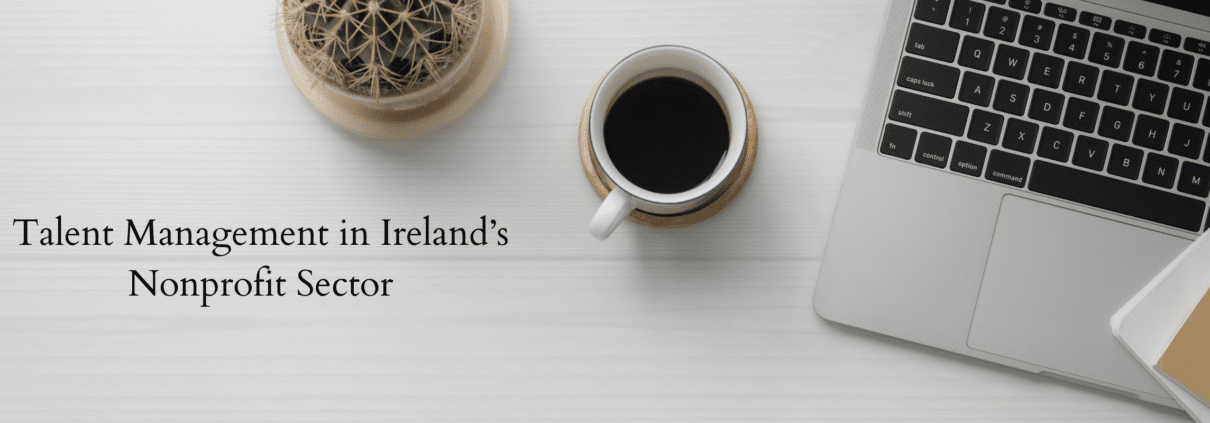Talent Management in Ireland’s Nonprofit Sector
Nobody at this stage needs to hear any more analysis of how the last two years has impacted on their sector, or what the likely impact will be of the war in Ukraine or current inflationary challenges. What you do need to hear however, is that you are not alone. A recent survey by the Chartered Institute of Personnel and Development (CIPD) showed that 85% of organisations they spoke with said that they are struggling with skills shortages.
This is happening not just because of COVID, Ukraine or inflation. When the impact of COVID is stripped out of the figures, the current rate of unemployment is about the same as it was back in 2019, which is effectively full employment. We also have a workforce with shifting requirements in terms of their careers, a shift that started before March 2020, and manifesting itself in people seeking to take time-out, move to part-time work, and improve their work-life balance.
As a recruiter, I know that Recruitment can often be quite a reactive activity. Someone hands in their notice and you need to replace them as soon as possible. Proactivity may not be always possible in this area, but there is the possibility of becoming more proactive in other areas of talent management, to allow you to become altogether more strategic.
Changes

Like every other part of managing a nonprofit, talent management has changed in the last two years. The question is though: is this a short-term phenomenon, or is the landscape for the next few years, and even forever, changed fundamentally?
These changes have as been driven by several factors, not least of which was the necessity of having to work remotely. In recruitment, all candidate interaction, from initial screening to full panel interviews, had to move online. If you had told employers in late 2019 that they would be recruiting staff at CEO level without ever meeting them in-person, you would have been dismissed out of hand, but that is exactly what had to happen, and did happen.
Additionally, a lot of organisations put recruitment on hold during the uncertain times of the last two years, only to realise that the need for talent was not going away. This backlog of roles is still not fully cleared and has made the fight to attract the best candidates even more competitive. 2into3 tracks advertising activity in the sector for senior level roles to get a snapshot of activity every three months. In Q1 2022, there was an increase of just under 20% in the number of roles advertised versus the same period last year, with every sector bar one (Philanthropy & Volunteerism) showing an increase in activity.
Jobseeker activity is also changed and while we are not quite seeing what many have referred to as “The Great Resignation”, we are seeing what Mary Connaughton, Director of CIPD Ireland calls “The Great Re-evaluation”.
People are looking at an uncertain world and thinking carefully whether they want to leave a permanent, possibly pensionable, role for a new position which may have a six-month probationary period. They may also have secured a significant level of flexibility with their employer in terms of remote and hybrid working arrangements and are keen not to relinquish this.
In almost every interview I do, when I ask candidates if they have any questions at the end of our meeting, the first response is invariably a question in relation to remote or hybrid working. It is front of mind for nearly everybody I meet, and it needs to be so for employers. This can be discussed as a trial approach for now, while an approach that suits everyone is achieved, but be assured, it is something you will need to address.
Anecdotally, the desire for greater working from home arrangements is stronger in those holding more senior roles, or who have been in employment longer. Junior staff, including graduates, appear to keener on working more in the office. This is likely because of the strong desire they have for building social connections, especially if they have never actually worked in person with their colleagues. Those employees who were in the office and organisation pre-2020 have a much better understanding of the organisational culture and how they can work effectively (and how they are expected to work) within it.
The other significant shift we have seen is in terms of the number of people that could be termed “active jobseekers”. There are fewer people applying for each new role, which means for recruiters, a far greater emphasis is placed on the targeted search approach. In 2into3 we are spending a lot more of our time seeking out suitable individuals via our existing databases and networks, as potential candidates are not on the lookout, and need to be made aware of the opportunities.
We are still successfully getting the qualified candidates, but this is extending the time needed to complete recruitment assignments. Time is always a commodity in short supply for organisations that need the talent to keep delivering for their service users and for organisations who choose to manage their recruitment in-house, not having access to such networks can hinder progress significantly.
Adapting

What does the nonprofit sector need to do to better manage our talent? Are there opportunities rather than just challenges in the current climate? Given what we know about the recruitment challenges outlined above, it might be worth considering, if you have a skills gap and cannot find the talent you need, could you work with what you have, maybe structure things better and, in the process, hold on to your best people for longer?
This focus on both recruitment and retention will require a combination of both short-term solutions and long-term plans. One option is essentially a “make or buy” argument. A commitment to graduate development, while not an overnight fix to any skills gaps, could give you access to the brightest young minds who can bring new skills, perspectives, and energy to your organisation, and indeed the sector.
When recruiting at a more senior or experienced level, many organisations have been broadening their horizons somewhat, to consider applications from outside the nonprofit sector, but others are reluctant, for various reasons. The transferability of skills is not always possible, but is worth considering, if there is a core set of skills to work with.
It may also prove challenging when candidates feel they should be able to earn the same salary and benefits they enjoyed in the commercial sector, but as I say every time I meet with people looking to make this change, nobody moves to the nonprofit sector for the money. If you are coming from outside, you need to understand that to step across, you often need to step down a rung or two on the ladder in the short-term, before securing a longer-term step back up. Core skills, no matter how strong, may need a level of reorientation to a nonprofit context and with that will possibly come with a drop in salary or position.
Emphasising your employer brand in the context of your vision, mission, and values can help here, looking beyond the job description and making the work as attractive as possible for non-financial reasons, emphasising both the impact the candidate will have in the role and the job satisfaction that will follow.
For your existing team, the emphasis now is on developing a personalised employee/employer relationship. In this current market, employees have the power, and everyone will have different requirements of the relationship. Flexibility is key and not just in terms of hybrid or remote working. If possible, give people as much freedom as possible to do the work and deliver the required outputs by whatever means works best for all parties. This is not just location, but working hours as well, offering part-time work or even job sharing.
There could also be a customised approach to other areas, such as pay and benefits and career development, where this is possible. The key here is a person-centred approach, adapting to new processes and workflows that evolved during the pandemic, fitting in around individual needs as well as organisational requirements, rather than trying to shoehorn individuals into roles, or vice versa.
If in doubt, speak with people, understand what works best for them and their teams and, if that also works well for your organisation, then work to enable this. By understanding their requirements, you might also be able to secure their services for longer. Not every employee request will be possible, and two people doing a similar job may have competing requests, so staff will need to know not everything they ask for can be granted, but if a simple conversation can lead to agreement on adapted approaches that ensure staff are retained (and more productive), then it is a win for everyone.
The Future
As to where this is all heading, if the last few years have taught us anything, it’s that we cannot predict the future. The war in Ukraine could lead to fundamental shifts in the global economy, but it could also lead to a significant influx of highly motivated workers into the state. Inflation could stagnate at a high rate, it could keep rising, fuelled by pay claims to keep pace with the cost of living, or it could begin to drop. COVID may still have some life left in it, with variants and subvariants arriving without warning.
Each of these external factors, and many more besides, could have a significant impact on how you approach the task of talent management. There is one thing we do know, however. When the most fundamental changes to our world happened overnight, we adapted, and we worked through them, so don’t ever let anyone ever tell you that people cannot change. The lessons of the last two years will stand to us, and we will be better placed to ensure our organisation’s talent is managed well, both in the short and long term.


